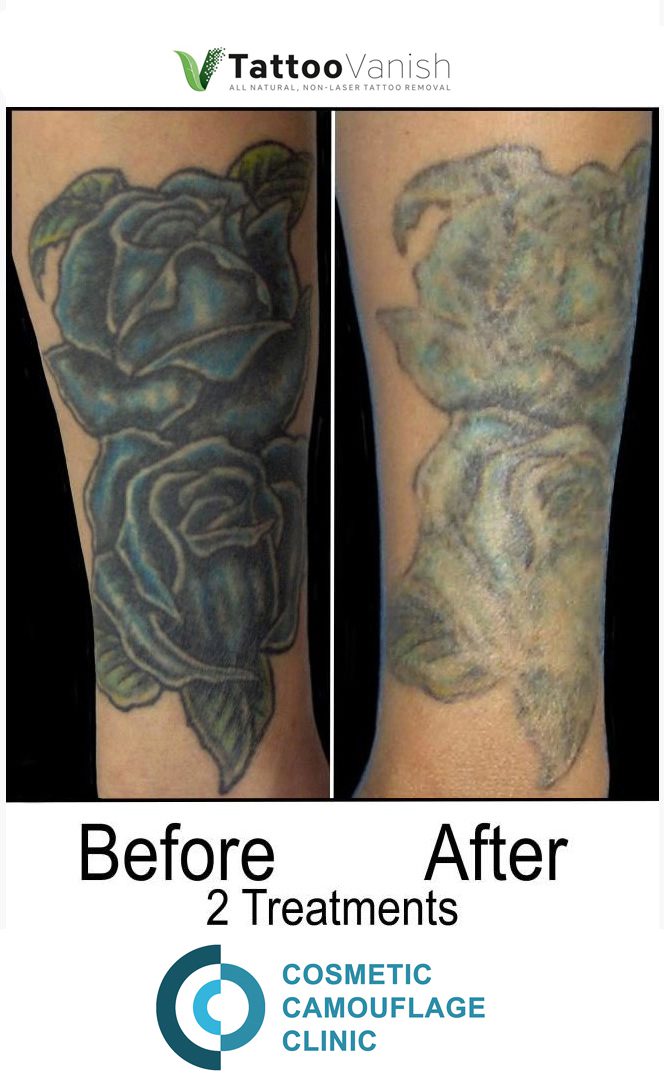Tattoo removal can be achieved in a number of ways, ranging from laser treatments, chemical peels, dermabrasion and surgical excision.
Table of Contents
Laser tattoo removal
Lasers are the most common method of tattoo removal performed today. Tattoos consist of thousands of particles of tattoo ink suspended in the skin. The normal human immune system typically removes small foreign particles from the skin. Tattoo ink particles are too big to be removed by this system and are thus considered permanent. The use of lasers helps to break up these particles into smaller pieces that can be removed by the immune system.
Laser treatments work by targeting the ink particles in the skin with highly concentrated light waves that heat up the ink particles and cause them to fragment into smaller particles that are able to be cleared away by the body’s immune system.
Complete removal of a tattoo is usually not accomplished in one laser treatment session. Laser tattoo removal typically requires more than one treatment to reduce the size of the ink particles and make it easier for them to be dispersed by the immune system.
Depending on the tattoo design, size and color, it may take 1-10 laser sessions to remove the ink. Some colors of ink are harder to remove than others and may not be able to be completely removed. There should be a six-week time period between each laser session to allow the wounds to heal and the body to absorb as much of the ink as is possible.
Laser tattoo removal is somewhat painful. Many patient describe it as like having a heavy rubber band snapped against the skin repeatedly. Topical skin numbing medications can be used. Most of the time laser tattoo removal is tolerated very well.
After the procedure the patient will have an open wound that will need to be taken care of. Typical post procedure care of the wound includes cleaning it with soap and water daily, applying antibiotic ointment to the wound and then keeping it covered with some type of dressing until it is healed. Typically, healing is complete around five days after the procedure is done.
Other methods of tattoo removal are more invasive than laser removal and are therefore less commonly performed today. These methods include dermabrasion, chemical peels and surgical excision of the tattoo.
Dermabrasion tattoo removal
Dermabrasion is a surgical method of tattoo removal that involves the use of a medical grinding tool that is used to remove the outer layers of the skin in a controlled manner. The intent is to remove the layers of the skin that contain the ink particles, thereby removing the tattoo.
This procedure is painful and because of this, is typically performed with either a local, regional or even a general anesthetic.
Like laser tattoo removal, a session of dermabrasion will result in an open wound that needs care after the procedure is done. Daily cleaning of the wound with soap and water, application of an antibiotic ointment and covering of the wound with a dressing are what is usually recommended.
The wounds created as a result of dermabrasion typically take longer to heal than those created by laser tattoo removal. These are likely to take somewhere around 10-14 days to heal.
Also, like laser tattoo removal, more than one session of dermabrasion may be necessary to remove a particular tattoo.
Dermabrasion can result in significant scaring and should only be performed by physicians well trained in the proper technique.
Chemical peel tattoo removal
Trichloroacetic acid (TCA) peels can also be used to remove tattoos. TCA is a mild acid that is applied to the skin to remove the outer layers of the skin, and with them, the tattoo ink.
This type of procedure may be mildly painful, but typically does not require the use of an anesthetic.
Like the other types of tattoo removal, TCA peels will result in an open wound that will need to be cared for after the procedure is completed. Daily cleaning with soap and water, application of an antibiotic ointment and a dressing are all that is necessary. These wounds will typically heal in approximately 5-7 days.
Surgical excision tattoo removal
Tattoos may also be removed by direct surgical excision. This involves simply cutting out the skin that contains the tattoo. This technique is best used for small tattoos and may not be practical for very large tattoos. The skin surrounding the tattoo is then brought together and closed.
This type of tattoo removal will likely require the use of a local, regional or even a general anesthesia depending on the size of the tattoo. A surgical scar will be created by this type of tattoo removal.
Post-procedure bandages should be left in place for 48 hours. Once the bandages are removed and the surgical site should be cleaned daily with soap and water. A dressing may be applied to cover the wound for the first week after surgery.
Does tattoo removal hurt?
There is some degree of discomfort when getting a tattoo removed, although the pain is relatively manageable. Sometimes, skin numbing can be used to help make the pain more tolerable.
Tattoo removal healing
It will take some time for the skin to heal after tattoo removal. Most side effects are temporary, with the most common reactions being redness, swelling, bruising, scabbing and tenderness. Most of the time these reactions resolve within a week.

